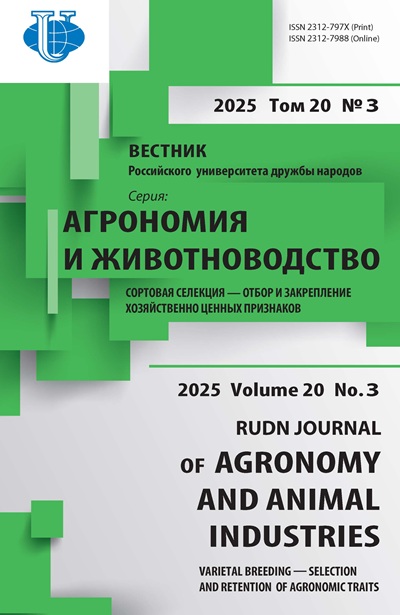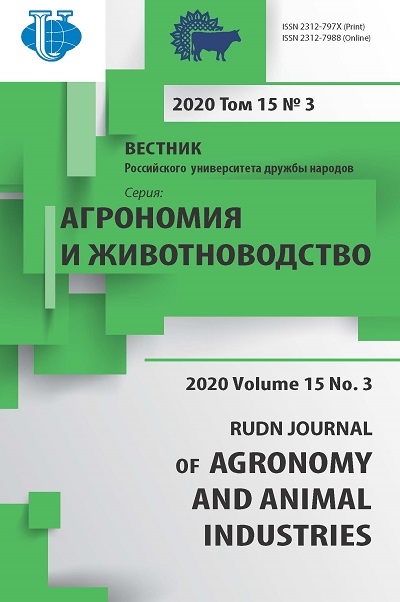Анализ оптимальности размещения географической сети длительных опытов по применению удобрений
- Авторы: Савин И.Ю.1,2
-
Учреждения:
- ФИЦ «Почвенный институт им. В.В. Докучаева»
- Российский университет дружбы народов
- Выпуск: Том 15, № 3 (2020)
- Страницы: 281-293
- Раздел: Почвоведение и агрохимия
- URL: https://agrojournal.rudn.ru/agronomy/article/view/19587
- DOI: https://doi.org/10.22363/2312-797X-2020-15-3-281-293
- ID: 19587
Цитировать
Полный текст
Аннотация
Основы Географической сети опытов с удобрениями России (ГСОУ), заложенные в 1930-1940 г., коренным образом не менялись, что обеспечивало преемственность научных исследований. Но с тех пор накопилось достаточно много новых научных данных, появились новые технологии, базы данных, на основе которых ГСОУ может и должна быть модернизирована. Рассмотрен один из вопросов необходимой модернизации ГСОУ - пространственное размещение опытных полей и их репрезентативности. В качестве основы использован Единый государственный реестр почвенных ресурсов России (ЕГРПР) для проведения анализа оптимальности размещения опытных полей ГСОУ. Считалось, что в идеале опытные поля должны характеризовать каждую почву, внесенную в ЕГРПР и используемую в качестве пашни. Согласно полученным данным, существующая сеть ГСОУ репрезентативна для 42 % пашни России. Показано, что для полной репрезентативности сеть должна быть расширена более чем на 90 точек. Только в этом случае результаты опытов могут быть экстраполированы практически на все пахотные почвы России. В основу размещения новых точек ГСОУ должна быть положена информация ЕГРПР как официального документа, принятого Минсельхозом России.
Ключевые слова
Об авторах
Игорь Юрьевич Савин
ФИЦ «Почвенный институт им. В.В. Докучаева»; Российский университет дружбы народов
Автор, ответственный за переписку.
Email: savin_iyu@esoil.ru
доктор сельскохозяйственных наук, академик РАН, заместитель директора ФИЦ «Почвенный институт им. В.В. Докучаева»; профессор, Экологический факультет, Российский университет дружбы народов
Российская Федерация, 109017, г. Москва, Пыжевский переулок, д. 7; Российская Федерация, 117198, г. Москва, ул. Миклухо-Маклая, д. 8Список литературы
- Иванов А.Л., Кирюшин В.И., Молчанов Э.Н., Савин И.Ю., Столбовой В.С. Анализ земельной реформы и агропромышленного производства за четверть века. Почвенно-экологические, технологические институциональные и инфраструктурные аспекты модернизации. Земельная служба (доклад). М.: Почв. ин-т им. В.В. Докучаева, 2016. 93 с.
- Rothamsted Long-term Experiments (2018 - reprinted 2019) Guide To The Classical And Other Long- Term Experiments, Datasets And Sample Archive, pp. 1-58. DOI: https://doi.org/10.23637/ROTHAMSTED-LONG-TERM-EXPERIMENTS-GUIDE-2018
- Macholdt J., Styczen M.E., Macdonald A.J., Piepho H.-P., Honermeier B. Long-term analysis from a cropping system perspective - Yield stability, environmental adaptability, and production risk of winter barley // European Journal of Agronomy. 2020. Vol. 117. P. 126056. doi: 10.1016/j.eja.2020.126056
- Романенков В.А. Агрохимические опыты в системе исследований Геосети: прошлое, настоящее и будущее // Известия ТСХА. Вып. 3. 2012. С. 54-61.
- Романенков В.А., Шевцова Л.К., Никитина Л.В. Географическая сеть опытов с удобрениями. Режим доступа: http://www.geo-set.ru/site/52 Дата доступа: 09.06.2020.
- Романенков В.А., Шевцова Л.К. Развитие методологии исследований по оценке динамики плодородия почв в длительных опытах Геосети // Совершенствование организации и методологии агрохимических исследований в Географической сети опытов с удобрениями: Материалы Всероссийской научно-методической конференции Географической сети опытов с удобрениями. М., 2006. С. 169-171.
- Сычев В.Г., Романенков В.А. Состояние и перспективы агрохимических исследований в Географической сети опытов с удобрениями // Материалы регионального научно-методического совещания ученых-агрохимиков Географической сети опытов с удобрениями Северного Кавказа / под ред. В.Г. Минеева, В.Г. Сычева. М.: ВНИИА, 2007. C. 14-25.
- Сычёв В.Г., Романенков В.А., Шевцова Л.К., Рухович О.В. Современные направления исследований и результаты длительных полевых опытов Геосети // Плодородие. 2014. № 5. С. 2-5.
- Сычев В.Г., Романенков В.А. Основные итоги и стратегия развития Географической сети опытов с удобрениями // Состояние и перспективы агрохимических исследований в Географической сети опытов с удобрениями: Матер. межд. науч.-метод. конф. Геосети 10-11 июня 2010 г. М.: ВНИИА, 2010. С. 3-7.
- Сычев В.Г., Романенков В.А. Основные итоги и стратегия развития Географической сети опытов с удобрениями // Агрохимические свойства почв и приемы их регулирования. V Сибирские Прянишниковские агрохимические чтения, 12-16 июня 2010 г. Новосибирск, 2011. С. 24-31.
- Романенков В.А., Шевцова Л.К. Длительные опыты геосети в современных и перспективных агрохимических и агроландшафтных исследованиях // Агрохимия. 2014. № 11. С. 3-14.
- Единый государственный реестр почвенных ресурсов России. Версия 1.0. М.: Почвенный институт им. В.В. Докучаева Россельхозакадемии, 2014. 768 с.
- Прянишников Д.Н. К вопросу о химизации нашего земледелия: Избр. соч. Т. 4. М.: Изд-во АН СССР, 1955. 503 с.
- Савин И.Ю., Столбовой В.С., Аветян С.А., Шишконакова Е.А. Карта распаханности почв России // Бюллетень Почвенного института имени В.В. Докучаева. 2018. № 94. С. 38-56. doi: 10.19047/0136-1694- 2018-94-38-56
- Конюшков Д.Е., Хохлов С.Ф., Контобойцева А.А., Савицкая Н.В. Государственная почвенная карта и ее создатели // Бюллетень Почвенного института имени В.В. Докучаева. 2015.№ 81. С. 12-44. doi: 10.19047/0136-1694-2015-81-12-44
- Гайдамака Е.И., Розов Н.Н., Шашко Д.И., Бондарчук Н.П., Булгаков Д.С., Вадковская Н.Н., Важов В.И., Газизов Ю.А., Глушкова М.И., Добровольский Г.В., Жуков В.М., Каменецкая Ф.Н., Карманов И.И., Колосовская В.Н., Лойко П.Ф., Назирова Б.Т., Норкина Т.Е., Носов С.И., Покровская Н.Д., Сенин А.И., Сотников В.П., Урусевская И.С., Федорин Ю.В., Фриев Т.А., Шувалов С.А., Ямпольская Е.М. Природно-сельскохозяйственное районирование и использование земельного фонда СССР. М.: Колос, 1983. 336с.
- Почвенная карта России и сопредельных государств. Масштаб 1:4 000 000 / И.П. Гаврилова, М.И. Герасимова, М.Д. Богданова (при участии Н.П. Лебедева). М.: Роскартография, 1995.
- The European Soil Database distribution version 2.0, European Commission and the European Soil Bureau Network, CD-ROM, EUR19945 EN, 2004
Дополнительные файлы















